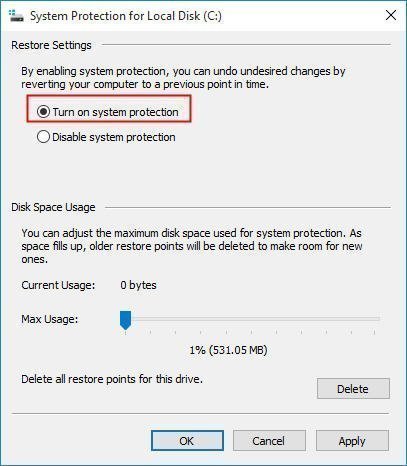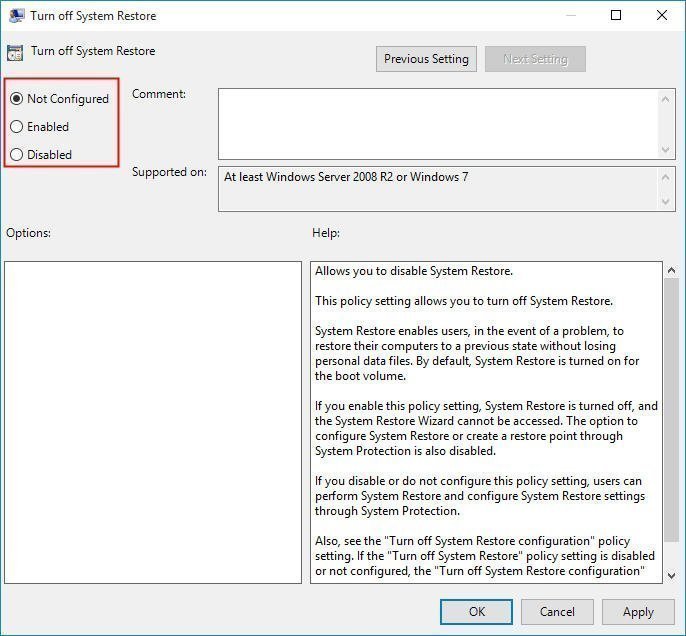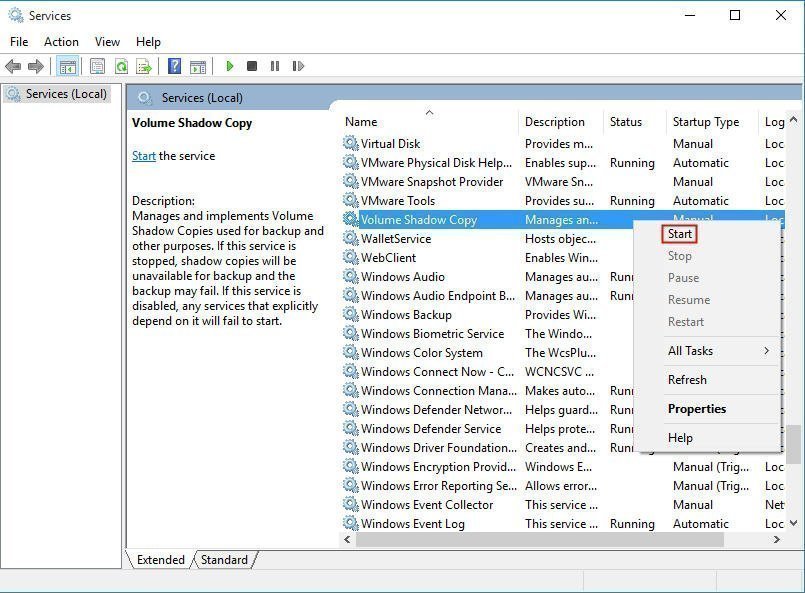Solved: Can't Create Restore Point in Windows 10, 11 | 4 Ways
- Overview of system restore point in Windows 10
- Unable to create system restore point in Windows 10
- Cannot create restore point in Windows 10 or 11? 4 ways to fix it
- Fix 1: Turn on system protection
- Fix 2: Enable system restore via Group Policy Editor
- Fix 3: Start Volume Shadow Copy service
- Fix 4: Run SFC/Scannow command
- Better way to protect your computer continuously
Overview of system restore point in Windows 10
System restore point in Windows 10 or Windows 11 holds important system files like registry keys on a specified data. System restore point can be used to restore your system to its early point. And when your computer is unbootable, you can try to fix this problem by restoring your system in Safe Mode using restore point. And it is advised to check the affected programs before restoring system.
Unable to create system restore point in Windows 10
Situation 1: I have a computer running Windows 10 and I intended to create a system restore point, so that I can restore my computer to previous state. But when right clicked “This PC”, went to “Prosperities” > “System Protection”, I found out that the option of “Create…” was grayed out.
Situation 2: I plan to create a system restore point in Windows 10. However, I failed to create system restore point and received an error that “The restore point could not be created for the following reason: Access is denied. (0x8007005).” Then I rebooted my computer and tried to restore point again, but I still received the same error message. How can I fix this issue? Is there anyone can help me?
Cannot create restore point in Windows 10 or 11? 4 ways to fix it
Apart from “Access is denied” error, it is also possible to see other errors like “The restore point could not be created for the following reason: The specified object was not found” during creating restore point. Since system restore point plays an important role, it is worthwhile finding out solutions when you failed to create restore point in Windows 10.
In fact, unable to create restore point can be caused by many events and you can try the tricks given below according to your situation.
*The following methods are also available for windows 11.
Fix 1: Turn on system protection
If you turn off the system protection, the option of “Create…” will be grayed out. Do as the following steps to turn on system protection.
1. In System Protection interface, select system drive and click “Configure…” icon.
2. In the pop-up window, choose “Turn on system protection” and click “Ok”.
Fix 2: Enable system restore via Group Policy Editor
In System Protection interface, if you happen to see that both “Create…” and “Configure…” grayed out, you can fix this issue using Group Policy Editor.
1. Press Windows + R simultaneously to open Run box.
2. In Run box, type “gpedit.msc” and hit “Enter” to open Group Policy Editor.
3. Under Computer Configuration, go to “Administrative Templates” > “System” > “System Restore”.
4. Then, you can check the state of Turn off Configuration & Turn off System Restore. If any of them is in Enabled State, double click it and choose "Not Configured".
Fix 3: Start Volume Shadow Copy service
When “Create…” option is available and you finally fail to create restore point and receive an error message, you can take steps as follows:
1. Open Run box and input “services.msc” and hit “Enter” to run Windows Services.
2. Find out the service named Volume Shadow Copy. Start it if it is not running; Stop and Restart it if it is running.
3. Make sure that the Startup type is "Automatic".
Fix 4: Run SFC/Scannow command
Windows system files corrupted can also cause the failure of creating restore point. You can use SFC utility to check and fix corrupted system files. The detailed steps are listed below:
1. In Startup box, type “cmd”, right click “Command Prompt” and choose “Run as administrator”.
2. In this window, type “sfc /scannow” and press “Enter” key.
Pleas wait patiently for this process to finish. If lucky, then you are able to create restore point in Windows 10.
Except for can't create restore point, you may also find system restore points gone in Windows 10 when you need to restore computer to an earlier date. There are many reasons and solutions, you could check them in the previous link.
Better way to protect your computer continuously
System restore point can help you to restore system to an early point. But after system restore, some programs like antivirus tool might be affected. And System restore point can’t help you to remove virus or malware; if the volume that holds system restore point is corrupted, it will not work. In such circumstance, it is wise to make a full backup of your system.
Here I recommend you Qiling Disk Master, a powerful and comprehensive backup tool for Windows 11, 10, 8, 7, XP, Vista. It allows you to create system image backup and restore it to a new hard drive if your current drive dies. With three image compression levels for you to choose, you are capable of saving disk space. Let’s see how it works:
Step 1. Free download Qiling Disk Master Standard, install and run it.
Step 2. In the main interface, go to “Backup” > “System Backup”.
Step 3. This software will choose source partition automatically for you. Select another location as the destination path. Then, select daily/weekly/monthly schedule backup and click Proceed to perform backup task continuously.
Notes:
☞The destination path can be an internal hard drive, external hard drive or NAS. It is recommended to backup system to external hard drive or NAS.
☞You can set scheduled backup by clicking “Schedule” button. There are 5 types for you to choose: Daily, Weekly, Monthly, Event Triggers and File Sync. But Event Triggers and File Sync are not available in Standard Version. If you want to use the two schedules, you can upgrade AOEMI Disk Master to Professional Version.
Related Articles
- How to Perform System Restore in Safe Mode Windows 10
- How to Delete System Restore Points in Windows 7/8/8.1/10
- System Restore Did Not Complete Successfully - Fixed for Windows 10/8/7
- Windows 7 Backup Encryption and Your File Encryption Key
This article introduces you to Windows 7 backup encryption workarounds and 'Back up your file encryption key' solutions.






